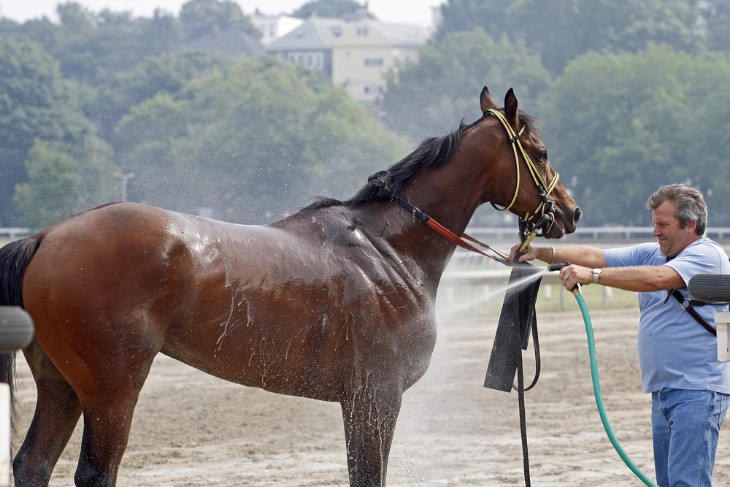- Understanding the Declaration Process
- The Role of Trainers and Owners in Declarations
- Key Deadlines in the Declaration Timeline
- Regulations Governing Horse Racing Declarations
- The Significance of Early and Final Declarations
- Different Types of Declarations in Various Countries
- The Economic Implications of Declarations in Horse Racing
- Conclusion
Understanding the Declaration Process
The declaration process in horse racing is a critical step in race preparation, involving several key stages. Firstly, the initial entry stage, where horses are entered for a race several weeks or even months in advance. This stage is crucial for race planners and handicappers to gauge the potential field size and quality. Following this, there is a stage known as the 'confirmation of entries,' usually occurring a few days before the race. During this phase, trainers confirm their intention to run their horse, based on factors such as health, training progress, and race conditions.
The final declaration stage, typically 24 to 48 hours before the race, is where the final line-up is confirmed. At this point, trainers must make a final decision on whether their horse will participate. This decision is influenced by various factors, including:
- The horse's health and fitness level.
- The suitability of the race distance and surface.
- The competition and potential for success.
The declaration process is governed by strict rules set by racing authorities. These rules ensure fairness and transparency, with penalties for non-compliance. This process is not just a formality; it plays a crucial role in the strategic planning of trainers and owners. Decisions made during the declaration stages can significantly impact the horse's chances of success and the overall dynamics of the race.
The Role of Trainers and Owners in Declarations
Trainers and owners play a pivotal role in the horse racing declaration process. Their decisions are guided by a combination of strategic planning, knowledge of the horse's capabilities, and an understanding of the race conditions. Trainers are responsible for assessing the horse's readiness, taking into account various factors that influence the decision to race. These include:
- Horse's Fitness: Assessing whether the horse is in peak physical condition to compete.
- Training Progress: Monitoring the horse’s training regime and performance in workouts.
- Race Conditions: Evaluating whether the race distance, surface, and competition level are suitable for the horse.
Owners, on the other hand, often have the final say in the decision-making process. Their objectives can vary from purely competitive aspirations to financial considerations. Some key aspects that owners consider include:
- Investment Return: Weighing the potential earnings against the cost of entering the race.
- Horse's Value: Considering how the race outcome could affect the horse's value, particularly for breeding purposes.
- Prestige and Reputation: The significance of the race and its impact on the owner's reputation in the racing community.
The collaboration between trainers and owners is crucial in this process. Effective communication and trust in each other's expertise are essential for making informed decisions that align with both the horse's welfare and the owner's goals.

Key Deadlines in the Declaration Timeline
The declaration timeline in horse racing is structured around several key deadlines, each serving a specific purpose in the race organisation process. The timeline typically begins with the initial entry stage, which can occur several weeks or months before the actual race. This stage is critical for race organisers to gauge the potential field size and for bettors to start forming early opinions.
Following the initial entries, there is usually a stage known as the 'scratchings' or 'withdrawals' deadline. This is when trainers can withdraw their horses without penalty, usually a few days before the race. This deadline is crucial as it offers trainers the flexibility to make decisions based on the horse's recent training performance and wellbeing.
The final declaration stage, typically 24 to 48 hours before the race, is the most critical. This is when the final field is confirmed, and no further withdrawals are permitted without a valid reason, such as a veterinary issue. The key deadlines in the declaration timeline are:
- Initial Entry Deadline: The first stage where horses are entered into the race.
- Scratchings/Withdrawals Deadline: The stage where horses can be withdrawn without penalty.
- Final Declaration Deadline: The final stage where the racing field is confirmed.
Adherence to these deadlines is essential for the smooth functioning of the racing event. It ensures fairness and provides clarity to all stakeholders involved, including trainers, owners, bettors, and race organisers.
Regulations Governing Horse Racing Declarations
Horse racing declarations are governed by a set of regulations designed to ensure fairness, transparency, and the welfare of the horses. These regulations vary slightly from country to country but generally follow similar principles. In the UK, the British Horseracing Authority (BHA) sets out the rules and guidelines for declarations. The regulations cover various aspects, including:
- Deadline Compliance: Strict adherence to the declaration deadlines is mandatory. Failure to comply can result in penalties or disqualification.
- Horse Eligibility: Ensuring that only eligible horses are declared for the race. This includes age, breeding, and qualification criteria.
- Disclosure of Information: Trainers are required to disclose accurate information about their horses, including any medication or treatments they have received.
The regulations also address issues related to horse welfare. For example, horses must pass a fitness examination before being declared. This rule is in place to prevent injury and to ensure that only healthy horses compete. Other welfare-related regulations include:
- Veterinary Checks: Mandatory health checks to confirm the horse's fitness to race.
- Medication Rules: Strict guidelines on the use of medication, with penalties for non-compliance.
- Rest Periods: Rules regarding the minimum rest periods between races for horses.
These regulations play a crucial role in maintaining the integrity of the sport. They protect the interests of all participants and ensure that horse racing remains a fair and competitive sport. Compliance with these regulations is monitored by the respective racing authorities, who have the power to enforce penalties for any breaches.
The Significance of Early and Final Declarations
Early and final declarations are critical stages in the horse racing declaration process, each carrying its own significance for the trainers, owners, and bettors.
Early Declarations:
- Serve as an initial indication of the potential field for a race.
- Allow trainers and owners to express their intent to race, subject to changes based on the horse’s condition and other factors.
- Help bettors and race analysts to start forming early predictions and strategies.
Final Declarations:
- Represent the commitment to run, barring any unforeseen circumstances like last-minute injuries.
- Are crucial for finalising betting odds and strategies, as the confirmed line-up is known.
- Enable race organisers to finalise preparations, including racecards and media releases.
The early declaration stage is often used as a strategic tool by trainers and owners. It allows them to keep their options open while monitoring the competition and the horse's readiness. The final declaration, however, is a commitment. Once a horse is declared at this stage, it is expected to run unless a valid reason is presented for withdrawal.

Different Types of Declarations in Various Countries
The declaration process varies from country to country, each with its own set of rules and traditions. Understanding these differences is crucial for those involved in international horse racing, including trainers, owners, and bettors.
United Kingdom:
- Operates under the rules set by the British Horseracing Authority (BHA).
- Features a multi-stage declaration process including initial entries, confirmations, and final declarations.
United States:
- Has a somewhat different approach, with entries usually closing 48 to 72 hours before the race.
- The process is overseen by individual state racing commissions, leading to some variations across states.
Australia:
- Similar to the UK, with a multi-stage declaration process.
- Managed by Racing Australia, with specific rules for different types of races.
In addition to these differences, certain prestigious races around the world may have unique declaration processes. For example, races like the Epsom Derby in the UK or the Melbourne Cup in Australia have specific traditions and rules that reflect their status and history. Bettors and racing enthusiasts need to be aware of these variations to fully understand and appreciate the complexities of horse racing across different regions.
The Economic Implications of Declarations in Horse Racing
The declaration process in horse racing has significant economic implications, impacting various stakeholders in the industry. These effects can be observed in different areas:
- Betting Markets:
- Declarations influence betting odds and strategies, affecting how bettors place their wagers.
- Late withdrawals or unexpected entries can cause fluctuations in betting odds, impacting the betting market's dynamics.
- Race Organisers and Venues:
- The number and quality of declarations can affect ticket sales and viewership, impacting revenue.
- High-profile horses or large fields can attract more spectators and media attention, enhancing the economic value of the race.
- Owners and Trainers:
- Decision-making in declarations can have financial consequences, especially in races with large purses.
- Strategic declarations can maximise earnings and the value of the horse, especially for future breeding prospects.
The economic impact of declarations extends beyond the immediate stakeholders. It also influences vendors, sponsors, and the local economy, especially during major racing events. The ripple effect of these economic implications underscores the importance of the declaration process in the broader context of the horse racing industry.
Conclusion
In summary, the declaration process in horse racing is a complex and multifaceted aspect of the sport, with far-reaching implications. It involves careful strategic planning by trainers and owners, and is governed by a set of regulations to ensure fairness and the welfare of the horses. The process is influenced by various factors including weather conditions, technological advancements, and economic considerations. The significance of this process is illustrated through various case studies, demonstrating the impact of declarations on the outcomes of races and the wider horse racing industry.








